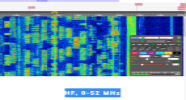Registe-se, faça a sua apresentação e terá acesso total ao TX&RX Fórum. ___________________________ Apresente-se dizendo quem é, escreva algo sobre si. Exemplo: Nome, indicativo, nome de estação, localidade, o que mais gosta de fazer no mundo das radio-comunicações e outras coisas que ache importante para a sua apresentação. Se é novato não tenha vergonha de o dizer, pois cá estamos para o ajudar.
___________________________ O TX&RX Fórum destina-se à publicações de mensagens "posts" relacionados com todos os assuntos sobre Radio Frequência. Essas mensagens têm como objectivo promover ideias, experiências, projectos, esclarecer duvidas, divulgação de actividades e publicações de novidades sobre Radio Comunicações.
Divirta-se!!
___________________________ O TX&RX Fórum destina-se à publicações de mensagens "posts" relacionados com todos os assuntos sobre Radio Frequência. Essas mensagens têm como objectivo promover ideias, experiências, projectos, esclarecer duvidas, divulgação de actividades e publicações de novidades sobre Radio Comunicações.
Divirta-se!!
8.5 dB de ganho para menos de US $ 40,00 - 50MHz Yagi
Página 1 de 1
 8.5 dB de ganho para menos de US $ 40,00 - 50MHz Yagi
8.5 dB de ganho para menos de US $ 40,00 - 50MHz Yagi
[Tens de ter uma conta e sessão iniciada para poderes visualizar esta imagem]
by W3GAS
The Yagi is one of the simplest directional antennas you can build today. There are no moving parts, and the Yagi can be matched to 50 OHM very easily using GAMMA or T-MATCH. My preference is the GAMMA MATCH. The antenna is totally in the ground circuit of the coax and only the GAMMA match is tuned to the frequency of choice. (We will discuss the GAMMA match later in the article). Please understand that there are some formulas you should keep in mind. These are available in the Antenna Handbook and many other reference books. I use Joesph Carr’s book “Practical Antenna Handbook” because it is written with simple in mind. That means, simple, not incorrect or misleading…just simple.
The length of the elements from above were taken from these formulas, but they are NOT on the money. They best fit the need for this low budget application. Here then is the formula that you can use, if you decide to tune the beam to fit your needs. All beams in HF are derived from this formula:
ELEMENT LENGTH L = K/F (L is length, F Frequency in MHz. and K is the constant)
SPACING is based upon 0.15 – 0.31 wavelengths, although I generally use 0.2 – 0.25.
The K constant is 492 for the REFlector, 492 for the DRIven element and 462 for Director2 and 460 for Director1 (457 for Director3 if added).
Remember that there is a FREE TO USE software program that implements these same formulas and takes a lot of the guess work out of design. The link is located lower in this text.
The feedpoint will naturally be 72-75 ohms. After all most designs use a DIPOLE MATCH system and while most Ham’s are more familiar with a DIPOLE, this is not the best way to match a parasitic array. What tends to happen is based upon any DIPOLE in free-space. As soon as we add elements and adjust height off ground the Dipole match tends to change impedance and we come away with an antenna that may be difficult to tune, especially while up on the roof or tower. While on the ground it seems perfect, put it in the air and it just ain’t the same. Remember that additional elements will change the center of balance and that places the driven element further away from the main mast center point. Adjusting a DIPOLE element on the tower is damn near impossible…
- READ FULL ARTICLE
[Tens de ter uma conta e sessão iniciada para poderes visualizar esta imagem]
by W3GAS
The Yagi is one of the simplest directional antennas you can build today. There are no moving parts, and the Yagi can be matched to 50 OHM very easily using GAMMA or T-MATCH. My preference is the GAMMA MATCH. The antenna is totally in the ground circuit of the coax and only the GAMMA match is tuned to the frequency of choice. (We will discuss the GAMMA match later in the article). Please understand that there are some formulas you should keep in mind. These are available in the Antenna Handbook and many other reference books. I use Joesph Carr’s book “Practical Antenna Handbook” because it is written with simple in mind. That means, simple, not incorrect or misleading…just simple.
The length of the elements from above were taken from these formulas, but they are NOT on the money. They best fit the need for this low budget application. Here then is the formula that you can use, if you decide to tune the beam to fit your needs. All beams in HF are derived from this formula:
ELEMENT LENGTH L = K/F (L is length, F Frequency in MHz. and K is the constant)
SPACING is based upon 0.15 – 0.31 wavelengths, although I generally use 0.2 – 0.25.
The K constant is 492 for the REFlector, 492 for the DRIven element and 462 for Director2 and 460 for Director1 (457 for Director3 if added).
Remember that there is a FREE TO USE software program that implements these same formulas and takes a lot of the guess work out of design. The link is located lower in this text.
The feedpoint will naturally be 72-75 ohms. After all most designs use a DIPOLE MATCH system and while most Ham’s are more familiar with a DIPOLE, this is not the best way to match a parasitic array. What tends to happen is based upon any DIPOLE in free-space. As soon as we add elements and adjust height off ground the Dipole match tends to change impedance and we come away with an antenna that may be difficult to tune, especially while up on the roof or tower. While on the ground it seems perfect, put it in the air and it just ain’t the same. Remember that additional elements will change the center of balance and that places the driven element further away from the main mast center point. Adjusting a DIPOLE element on the tower is damn near impossible…
- READ FULL ARTICLE
[Tens de ter uma conta e sessão iniciada para poderes visualizar esta imagem]

ALF007- Administrador Fundador
 Tópicos semelhantes
Tópicos semelhantes» 6 el 50MHz LFA-R reflectorless Yagi
» Converter radio CB para 6 metros 50Mhz
» Antena Direcional Yagi 4 Elementos para UHF
» Yagi de 7 elementos para 11 metros - 27,555
» Nova Yagi de 6 elementos para HF
» Converter radio CB para 6 metros 50Mhz
» Antena Direcional Yagi 4 Elementos para UHF
» Yagi de 7 elementos para 11 metros - 27,555
» Nova Yagi de 6 elementos para HF
Página 1 de 1
Permissões neste sub-fórum
Não podes responder a tópicos












 por
por 





